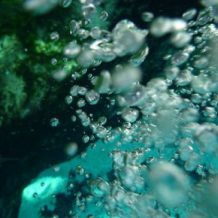health and science
Ginnie Springs
The Ginnie springs group is recognized throughout the world as one of Florida’s most beautiful and unique ecosystems.The Wray family has fought to protect it for many years. But since the groundwater basin extends for miles from the springs, it will take the unified will of Florida’s citizens to conserve it and to ensure that it continues to be one of Florida’s natural wonders. Both declining flows and water quality are of concern, due to agricultural development in the springshed.
Quantity
While recent drought has contributed to a decrease in spring flow, it does not fully explain the flow decreases in the Santa Fe River. Review of historic rainfall and stream flow data for the Santa Fe River indicate that there has been about a 20% decrease in rainfall totals at the US 47 Bridge (just downstream of Ginnie Springs) since 2001, and an overall 40% reduction in stream baseflow – primarily contributed by springs like the Ginnie springs group. This means that long-term declines in spring and river flows are a response to both decreased recharge (rain) and increased groundwater pumping.
Quality
The Santa Fe River and its’ springs are classified as an “Outstanding Florida Waterway” (OFW) by the Florida Department of Environmental Protection (FL DEP). By law, they must receive the highest level of water quality protection and may not be degraded by human activities. This includes activities performed under consumptive use permits (CUPs), which in unconfined areas of the aquifer almost invariably result in nitrate pollution.
Despite the OFW classification, the amount of nitrate nitrogen in the Santa Fe River and springs is currently 10x higher than historical background levels. This means that since 1984 when this water body received the OFW designation, the FL DEP has not acted in accord with its own legal standards. In other words, the OFW designation has been violated; it has not been used as intended to protect the Santa Fe River and springs from increasing levels of pollution.
Elevated nitrate levels (above 0.35 mg/L) cause springs to suffer in many ways, namely in the growth of excessive algae, the loss of the native submerged aquatic plants, and declining aquatic productivity that is required to support the fish and other wildlife populations that naturally inhabit the springs and river. Higher nitrate levels (above 10 mg/L) further alter the natural aquatic ecosystem and also make the water unsafe for humans to drink.
It’s important to remember that levels of nitrate nitrogen contamination considered safe for springs ecosystems are much lower than those considered safe for human consumption. At the Ginnie springs group, nitrate levels in the groundwater and springs are well below the FL DEP approved parameters for safe human consumption, but are at levels that are several times higher that what is safe for fish and other wildlife, and do not support healthy springs ecosystems.
To protect the health of Ginnie Springs and the Santa Fe River, the goal is to reduce the concentration of nitrate nitrogen in the groundwater feeding the springs to less than the 0.35 mg/L springs standard.
Nitrates enter the aquifer from a few principal sources, mainly through animal/human wastes and agriculture. Pastureland contributes 42% of the nitrates (mainly due to animal waste), fertilizers – urban and agricultural – contribute 38%, human wastewater makes up 18%, and atmospheric inputs are 2%. Ginnie Springs is in the downstream section of the Santa Fe River that continues to have rising nitrate levels – average nitrate concentrations at some Santa Fe River springs have increased by about 3,000% over the past 20 years. About 800 tons of nitrates per year are added to the river (measured just downstream of Ginnie Springs) – this is 10 times the pre-development level.
While some argue that the solutions to both the water quantity and quality problems are expensive, it is clear that action is needed to fix these pressing issues – and taking no action will, among a plethora of other negative impacts, result in huge economic losses for Florida (greater than $20 million per year). Santa Fe Springs Restoration Action Plan, FSI
Please refer to the “Springshed” category for more information and see the “Caring for your spring” section to see how you can help!
More info:
For a science-based report, see the Howard T. Odum Florida Springs Institute’s Santa Fe Springs Restoration Action Plan
- Presentation
For real-time water data (stream stage and stream flow, water quality, and groundwater levels), visit the USGS website.
For a comprehensive discussion of the effects of nutrient levels on springs, see “Summary and Synthesis of the Available Literature on the Effects of Nutrients on Springs Organisms and Systems,” published by the UF Water Institute in 2008.
For additional information on the science of springs, check out the Florida Springs Institute’s “Springs Resources” page.






